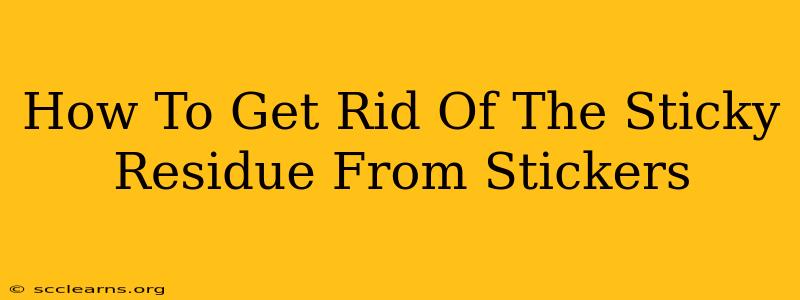Sticky residue from stickers is a frustratingly common problem. Whether it's from a price tag on a new purchase, a kid's sticker collection gone rogue, or an old decal that's finally met its end, that stubborn adhesive can seem impossible to remove. But don't despair! This guide will equip you with various methods to banish sticky residue and restore your surfaces to their former glory.
Understanding the Enemy: Sticker Adhesive
Before we dive into removal methods, it's helpful to understand what we're dealing with. Sticker adhesive is designed to stick – that's its job! It's typically a polymer that bonds to surfaces, creating a tenacious grip. The composition varies depending on the sticker, which influences the best removal technique. Some adhesives are more water-soluble, while others require stronger solvents.
Simple and Effective Methods for Removing Sticker Residue
Let's start with the easiest and most readily available solutions:
1. The Power of Heat: A Hair Dryer's Gentle Approach
Sometimes, all it takes is a little heat to loosen the adhesive's grip. Use a hairdryer on a low setting to gently warm the affected area. The heat softens the adhesive, making it easier to peel off with your fingernail or a plastic scraper. Be careful not to overheat the surface, especially if it's delicate like plastic or wood.
2. Isopropyl Alcohol (Rubbing Alcohol): A Versatile Solvent
Isopropyl alcohol (70% or higher concentration) is a highly effective solvent for many types of sticker residue. Simply apply a small amount to a soft cloth or cotton ball, gently rub the area, and wipe away the residue. For stubborn adhesive, let the alcohol sit on the residue for a few minutes before wiping. Always test in an inconspicuous area first, especially on delicate surfaces.
3. Vegetable Oil: A Natural and Gentle Solution
Believe it or not, vegetable oil can be a surprisingly effective method for removing sticker residue. Apply a small amount of oil to the sticky area, let it sit for a few minutes to soften the adhesive, then gently wipe away with a soft cloth. This method is particularly gentle and suitable for delicate surfaces.
4. Baking Soda Paste: For a Gentle Abrasive Action
For tougher residue, create a paste of baking soda and water. Apply the paste to the sticky area, let it sit for a few minutes, then gently scrub with a soft cloth or sponge. Baking soda acts as a mild abrasive, helping to lift the adhesive. Rinse thoroughly with water afterward.
5. White Vinegar: Another Natural Cleaning Powerhouse
White vinegar is another household staple with surprising cleaning power. Similar to rubbing alcohol, apply white vinegar to a soft cloth and gently rub the sticky area. You can also soak a cotton ball in vinegar and leave it on the residue for a while before wiping clean.
Dealing with Stubborn Residue: Escalating the Tactics
If the simple methods fail, you may need to employ slightly stronger tactics:
1. WD-40: A Powerful Solvent (Use with Caution)
WD-40 is a powerful solvent that can dissolve many types of adhesive. However, it's important to use it cautiously, as it can damage certain surfaces. Always test in an inconspicuous area first. Apply WD-40 to the residue, let it sit for a few minutes, then wipe clean with a cloth.
2. Goo Gone: A Specialized Adhesive Remover
Goo Gone is a commercially available adhesive remover designed specifically for sticky residue. Follow the manufacturer's instructions carefully.
Preventing Future Sticker Residue Problems
Prevention is always better than cure! Here are a few tips to minimize the chances of sticky residue:
- Use a plastic scraper: When removing stickers, use a plastic scraper (like a credit card) to help lift the sticker. This minimizes adhesive left behind.
- Peel slowly and carefully: Don't rush the process. Peel stickers slowly and gently to avoid tearing them, reducing the amount of adhesive left behind.
- Apply adhesive remover immediately: Address any sticky residue as soon as possible for best results.
By following these tips and methods, you can successfully remove sticker residue and keep your surfaces clean and beautiful. Remember to always test any cleaning solution on an inconspicuous area before applying it to the entire surface. Happy cleaning!

